How To Get Rid Of White Mold
- Mold Finder
- Glossary
- Library
White Mold Identification and Treatment
Identifying white mold growth in your home

White mold growth, while a common problem in residential homes, does not receive the same attention as black mold. Primarily this is due to the fears surrounding more well known black molds, such as Stachybotrys. However, many white molds are still capable of producing negative health effects and should be dealt with promptly. Curious what kind of white mold you're dealing with? Read up on mold testing before hiring a pro.
Common locations for white mold growth
Each type of mold has a preference for certain conditions. For example, stachybotrys often prefers highly saturated materials, such as sheetrock after a flooding event. Because of these preferences, white mold growth is often found in the same location. Below are the most common areas.
Furniture
Mold growth on furniture is often white in color. Additionally, the mold typically has a 3 dimensional, fuzzy growth aspect.

White mold growth on back side of dresser.
Clothing & Textiles
Clothing, shoes, backpacks – when mold attacks contents within the home, it's often white or light green in color. This is especially true for leather items. The good news? It's easier to remove white mold than black mold. While the latter often leaves behind permanent stains, white mold can often be fully removed.

White mold growth on leather sandals.

Textile, such as backpacks are often attacked by white mold.
Attic sheathing and framing
White mold tends to grow in high humidity environments rather than areas suffering from total saturation. This is why it's less common to see mold growth on base trim after a flooding event. The vast majority of attic mold is caused by humidity, which is why white mold growth is common here.

White mold growth inside an attic
Crawlspaces
White mold is often found in two locations in a crawlspace, exposed soil and the lower portions of the floor joists. In cool climates, mold growth on floor joists is rare. But when it occurs, it's often white in color.

Heavy white mold growth on floor joists.
In wet climates, exposed soil in a crawlspace will often propagate mold growth. Typically this is due to a missing or incomplete vapor barrier. The combination of an organic food source (dirt), excess moisture and limited airflow creates the perfect conditions for mold growth. In nearly all cases, white rather than black mold grows in the soil.

White mold growing on exposed soil in crawlspace.
Does white mold lead to wood rot?
In short – no. Rot (dry rot, wet rot, white rot, brown rot) is caused by wood decay fungi. These are distinct from molds and are relatively small in number in comparison to molds. They require much higher levels of available water to grow. The name 'dry rot' is a complete misnomer, as all rot requires elevated quantities of moisture.If you find white mold growing on a building material, it will not morph into rot.
However, this doesn't mean your wood won't rot. If you have a high quantity of moisture, eventually wood decay fungi will take over. This will happen regardless of whether or not you had any mold growing beforehand.

Heavy white mold growth in a crawl space.

Wood rot due to fungal growth.
How can I tell the difference between white mold and efflorescence?
White mold growth provides an additional challenge because it is often confused with efflorescence, a crystalline growth structure found on concrete and masonry surfaces. Efflorescence occurs when water moves through a masonry structure, bringing unbounded salts to the surface. When the water evaporates, a white, fluffy structure is left behind. This growth, while harmless, can appear very similar to white mold growth.
White mold can be found anywhere conditions conducive to mold growth are present. Common areas of white mold growth include attic sheathing and crawlspace framing.
A trained mold inspector can readily determine if the growth structure is from white mold or efflorescence. Additionally, efflorescence will typically dissolve under the application of a water mist, while mold growth will not. Other helpful distinguishing characteristics include the material of the substrate. Efflorescence will only occur on concrete, brick or other masonry structures. If you find a white mold like substance on sheet rock or wood, you can certainly rule out efflorescence. Another indication, though imperfect, is the presence of a mold smell. Efflorescence is odorless, while mold growth often produces a musty odor.

Efflorescence on Concrete

Can color be used to identify the type of mold?
You cannot positively determine the exact type of mold based on the color. To determine the specific type of mold, you'll need mold testing. However, the color can be used to rule out certain types of mold. For example, Stachybotrys is always black. If you find white mold growth on a pair of shoes, you can rest assured it is not stachybotrys. The same is true of chaetomium and a number of other mold types.
Unfortunately, many types of mold such as Cladosporium and Penicillium/Aspergillus come in a variety of colors. These molds can appear in everything from white or green to brown and black. This limits our ability to determine the exact type of mold by simply assessing its color. To fully identify the species or genus of mold a sample must be collected and sent to a lab for analysis.
A tape lift sample is often the best method for determining the type of mold growth. In the photo below a sample of white mold is being taken from attic sheathing. Lab testing determined the growth was Acremonium.

Tape lift sample of white mold growth.
Is white mold dangerous?
Many molds can provoke allergic responses in sensitive individuals. No area of significant mold growth within the home should be considered safe. Proper identification of the underlying cause, removal and cleanup should be performed regardless of the color of the mold growth.
What tests are used to identify white mold?
Direct mold sampling can be used to identify the species of white mold. Types of direct sampling include tape lift, swab and bulk samples. These samples are collected by a technician and sent to a laboratory for analysis. The lab will first determine if the suspect growth is mold, and if so, what species of mold.
Are there any special concerns for mold remediation when dealing with white mold?
Your approach to mold cleanup should remain the same regardless of the color. Remember, many types of molds, even non-toxic molds, are capable of causing an allergic response. Because of this, the color of the mold is inconsequential. Many non-allergenic molds are white, as are a number of allergenic molds. Confusing the issue even more is the fact that we simply don't know the allergenic capabilities of the vast majority of molds. Conclusion = treat them all the same.
*Heads up – I earn a small commission on sales through Amazon links. This helps cover the expense of running the website (and answering your questions!)
Your Questions – Our Answers
*Heads up – I earn a small commission on sales through Amazon links. This helps cover the expense of running the website (and answering your questions!)
Got a question? Ask it here and we'll post the answer below
Question:
I'm in a bungalow with 7month old twins. There is mold on every wall, most are black but one wall is whit and it is a fungal type growth on top of the wallpaper, it looks like rounded lumps of cotton wool. It's privately rented' what is it and what should i do?
If mold growth is visible on every wall, you're likely dealing with a humidity based problem. This occurs when a home has insufficient ventilation. If the home has poorly insulated walls, the problem will be more severe. Due to the severity of the mold growth, I recommend calling a local professional (but watch out for opportunist who overcharge). In the meantime, I recommend improving your ventilation by running your bathroom exhaust fan 24/7 and cracking a window if possible. This will reduce condensation throughout the home. If the bathroom does not have an exhaust fan, install a Panasonic WhisperGreen fan.
Question:
Will painting concrete keep efflorescence from coming back?
If the problem is fairly mild, painting the concrete will reduce or greatly slow down the return of the issue. However, if the problem is substantial, the vapor movement will cause the paint to bubble and peel. Make sure you use clean and prep the wall and use a paint specially formulated for concrete. Specialty coatings designed to stop vapor movement do exist, but they typically work best on new concrete.
It's always best to begin with an investigation of the moisture source. For example, check the downspouts above to ensure the water is directed away from the concrete wall.
Question:
Does bleach kill mold?
Yes, bleach can effectively kill/disable mold on hard surfaces. See this study. However, bleach has several negative characteristics (stains materials, unhealthy for humans, etc.) Therefore, mold remediation professionals often use alternative chemicals such as quaternary ammonium compounds. Organic, plant based chemicals such as Benefect are effective as well.
Question:
How do you clean the white mold off and keep it off? It's on the bottom of wood doors and trim and cabinets.
It's critical you first identify the cause of the mold. Without addressing the underlying moisture source, the mold growth will return. No chemical can prevent mold growth if elevated moisture is present. In time, the mold will simply grow on top of the new dust that settles on top of the cleaner/coating.
Assuming the area of mold growth is fairly small, the mold growth can be scrubbed off with a detergent/water solution. More powerful chemicals, such as bleach or quaternary ammomium compounds are necessary to kill the mold. However, because you're physically removing the mold by scrubbing and wiping, the killing power of the cleaner is not necessary. White mold growth can typically be removed without leaving lingering staining. If staining is visible after scrubbing, you'll have to sand and refinish the material to address the discoloration.
Question:
My father passed away recently. There are several antique pieces in his 70 year old home that I would prefer to keep. If I remove the mold with CLR Mold and Mildew remover, is it safe to bring them into my 20 year old house that is not experiencing any mold issues?
Yes, if you thoroughly remove the mold spores, there should be no danger in bringing the items into your home. After cleaning, you might see residual staining on the items. Staining is much more likely to occur with black mold vs. white mold. This is not active growth and poses no health threat.
If the items are non-porous, such as wood, plastic, etc. the cleaning should be fairly straightforward. Heavy scrubbing is not needed. Simply damp wipe the items with a cleaning agent. If the items are soft/porous, such as upholstered furniture, removing all the spores can be difficult. I would recommend a professional for the soft/porous items.
Question:
I found black mold all through my house. Is it safe to stay there?
There are two questions you need answered: 1. Is the mold growth currently affecting the air quality? 2. What is causing the mold growth?
If the mold growth is systemic, I recommend hiring a local company to inspect the home and collect an indoor air quality sample. 1-2 samples (non-viable) should be sufficient to determine the severity of the issue. Make sure they also evaluate the cause of the mold (i.e. high humidity, moisture intrusion, etc.) It's critical you determine the cause of the excess moisture that is ultimately creating the mold growth.
In the interim, keep a few windows cracked open and run the bathroom exhaust fans 24/7. This will provide a constant influx of fresh air and lower the mold spore count while you investigate. If you have asthma or are experiencing other serious symptoms, contact your doctor immediately.
Question:
Just found white mold on my basement sofa and wall to wall carpeting only 1 year old. Brick exterior home.
The first step is to identify the moisture source. There are 3 possibilities. 1.) Vapor emissions from the concrete slab. This occurs when water vapor travels upward through the slab. It's most common in older homes with missing vapor barriers. This can cause excess both moisture in the carpet and increased humidity in the air. The increased humidity can lead to mold growth on contents such as a sofa. 2.) Liquid water intrusions can have the same affect, but these are typically obvious (i.e. carpet is wet to the touch).
3.) The second possible cause is excess humidity due to poor ventilation and insufficient heat. Basements without adequate air flow and heat are prone to high humidity. Over time, this high humidity creates an environment conducive to mold growth.
Action steps: Purchase a relative humidity gauge and monitor the RH. Pull back the carpet in a corner and look for signs of water intrusion on the concrete and the carpet pad.
Question:
Will white mold cause rot in flooring such as sub flooring and floor joists?
Great question. Short answer = No, white mold will not cause rot.
Long Answer. Rot is caused by wood decay fungi. These are not considered molds and typically require much higher moisture levels to flourish. They also require much more time to grow. While mold can grow in a matter of days, wood decay typically requires months of saturation.
The prevention strategy is the same for both – get rid of the excess moisture.
While there are many thousands of types of mold, only a few types of fungi cause wood rot. If you observe white mold growing on your subfloor, that mold will not turn into wood decay fungi over time.
Question:
Our family just bought a bed online. It was delivered and on the headboard, there is some white fuzzy looking substances and we're a bit cautious. Is it possible to tell by the pictures?
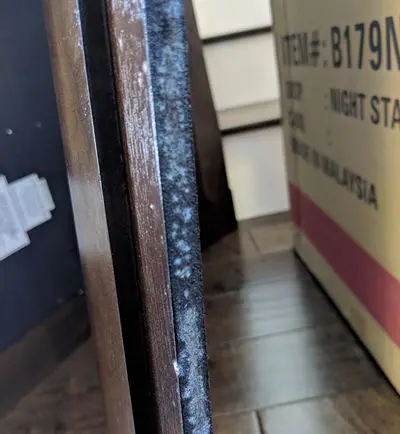
Based on the photo, it certainly looks like white mold growth. If you need definitive proof, I recommend a tape lift sample kit.
Question:
I need to store my shoes in plastic shoe boxes due to lack of closet space. If I drilled holes in the boxes would this be enough to keep the humidity down?
You're on the right track. Drilling holes will allow the shoes to breathe (as long as you don't put them away wet). You'll also need to ensure the closet does not have excess humidity. Make sure there is at least a 1/2″ air gap between the bottom of the door and floor/carpet. If it's an older home with poorly insulated walls, you might need to keep the door cracked slightly to allow heat to enter the closet. If humidity still remains a concern, consider placing a Damp Rid unit such as this or this.
Question:
Hello, I have this white/cream colored grown all over my home and was wondering if it is a type off mold. No one (my landlord, spouse, children, neighbors) believe that
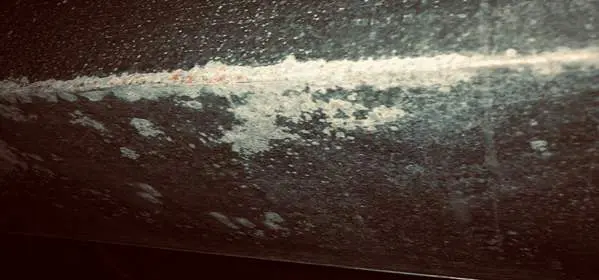
It's difficult to fully confirm from the photo. Does it have a fuzzy appearance? Does it wipe off with damp paper towel? If yes, it's likely mold. If it is crusty or difficult to wipe, it is not mold. I recommend a tape lift style test to confirm whether it is mold. If the test is positive, hire a local inspector to identify the source of the moisture. Systemic mold growth like this is usually due to humidity. Buy an RH gauge and try to maintain <50% throughout the home.
Question:
After many years of having this wall I've noticed this white fuzzy stuff on the paint. This is a decorated painted wall in my hallway, my shower is behind this wall. Could this be coming from a leak of some sort from shower? Here are some pictures.
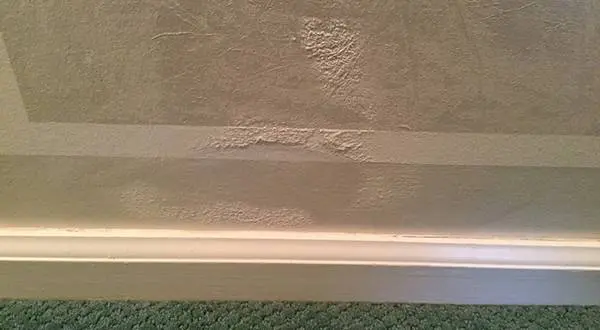
Yes, this looks like mold growth. Especially considering there is plumbing on the other side of the sheetrock. We can rule out condensation, because it's an interior wall. I recommend checking the wall with a moisture meter. If it's above 20% M/C you likely have a leak. Next, you'll need to determine if it's due to a supply line, drain line or shower surround failure.
Question:
I was up in my attic and I saw this. Is this mold?
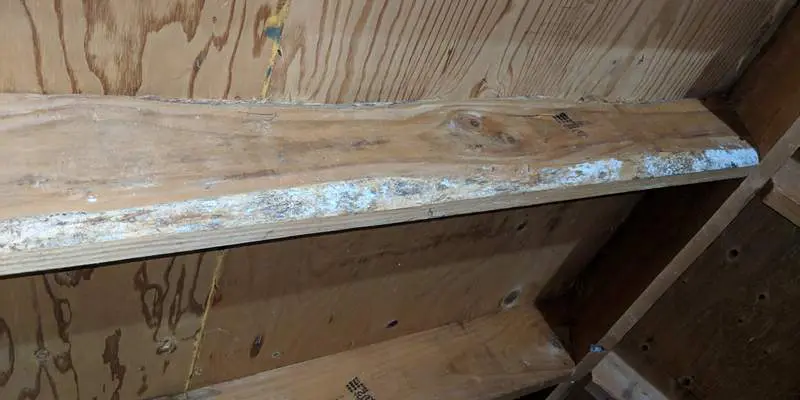
Yes, that is very likely mold growth. The amount shown in the photo is fairly minimal and would not cause structural degradation. If the mold growth is systemic throughout large portions of the attic, it's likely due to an ongoing condensation issue. If it's only in a limited area, it might be due to the original construction or a past, one time incident (mold doesn't fade with time).
If the mold growth is systemic, I recommend evaluating the ventilation (ridge and soffit). Also, check for disconnected bath fan ducts and a lack of air sealing on the ceiling.
Question:
Hi, this has appeared growing out of the holes in my air brick. Do you know what it could be? Thanks.
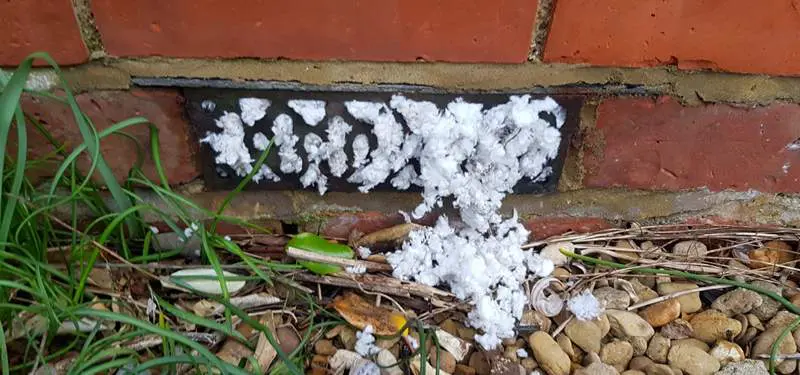
This looks like blown-in fiberglass insulation (efflorescence would dissolve with water and mold wouldn't have this kind of structure). It's pretty unusual to see insulation forced through a vented brick. Was the wall recently retrofitted with insulation? If so, the process might have forced insulation through the holes.
Question:
Hi, the attached image is of a growth on an interior hallway wall next to a doorway. It has been there for a while and the last time I redecorated about 6 months ago I chipped out this corner, refilled it and decorated. However it is back. It doesn't smell and this is the only place in the house that it exists. The house has suffered from condensation in the past but since I installed a PIV unit we get no condensation any more. Any idea what this may be? Thank you
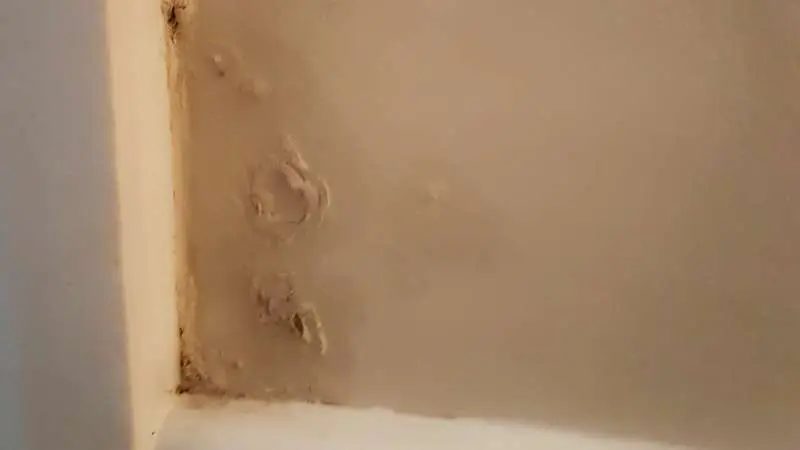
This is a bit strange. It certainly looks like distortion caused by a water intrusion. Condensation would not occur on an interior wall. Therefore the water must be coming from a liquid source (roof/ plumbing leak, etc.) I recommend renting or borrowing a moisture meter to verify the presence of water and trace the pathway to the source. If there is a bathroom above this area, check around the toilet and shower with a moisture meter. If it's the top floor, check the attic for a roof leak.
Question:
This is a internal wall in a prefabricated built bungalow . No water pipes on this wall. It is a plasterboard wall. Could it be rising damp?
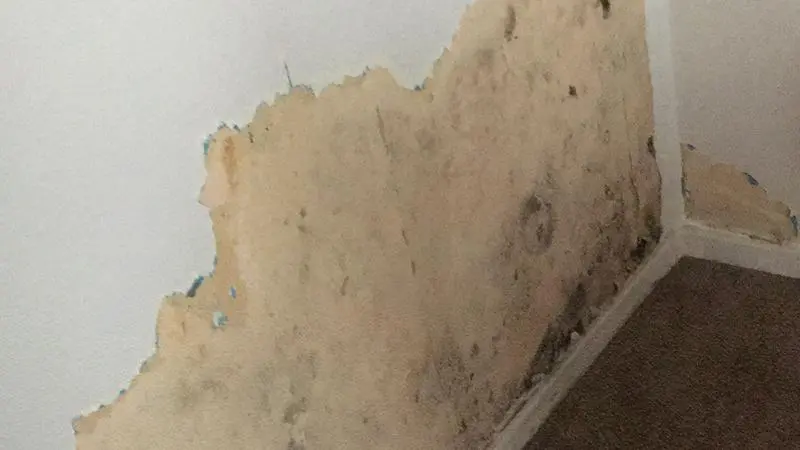
Rising damp (capillary action) will only occur if this wall sits on a concrete slab. If there is a crawl space below this floor, you're not dealing with capillary action. You'll need a moisture meter to verify the moisture source. These can often be rented at local construction rental shops. If it's dry, the mold is likely due to damp materials during the original construction of the wall. Because it's an interior wall, condensation is unlikely unless the interior RH is extremely high. If it's wet (and there's truly no plumbing in the wall), you might have a roof leak. Though rare, I've certainly observed roof leaks traveling down walls without leaving obvious damage on the ceiling.
Question:
I cannot see mould or damp on any walls nor solid wood floors of my 102 year old house, however black footwear both plastic & leather have a white film (like dust/powder) on them. Is this mould?
Assuming the shoes are stored in a closet, it is likely mold growth. White mold growth on shoes is nearly always due to high humidity. Closets in an older home often suffer from elevated humidity due to the lack of air flow and heat, combined with poorly insulated exterior walls. Keeping the closet door slightly open is often enough to solve the issue. This will allow heat to enter the area and moisture to escape. You can also assist the dry out by installing a moisture absorbing material such as Damp Rid.
Question:
Recently brought home boot molds that were exposed to NE flooding. Trying to save them. I see tiny amounts of white on them. White mold? They have not changed since brought home 4 days ago. We brought them into our basement. Was this a dumb move? Any way to save them?
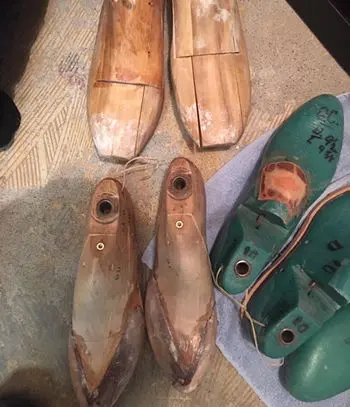
They can be salvaged, but it will require heavy cleaning. First, treat them with a mildicide such as Benefect. After this dries, vacuum any 3 dimensional growth (do this outside – as some spores will make it through the filter). Lastly, lightly sand the wood to remove any lingering mold staining. Wear a mask during the cleaning to minimize your exposure.
Question:
does white mold turn brown when it dies?
No, the color of the mold does not change. Instead of describing it as 'dying' we categorize it as active vs. inactive. When moisture is removed from the area, the mold goes dormant/inactive. Much like a seed, it can regrow once moisture returns to the area.
Question:
I recently renovated a bathroom. There is new sheetrock, plaster and paint. In this one area, the wall started bubbling. When we chipped away at the loose paint there was white "stuff" that grows back when removed. This wall is next to the tub/shower. Is this mold? What should I do?
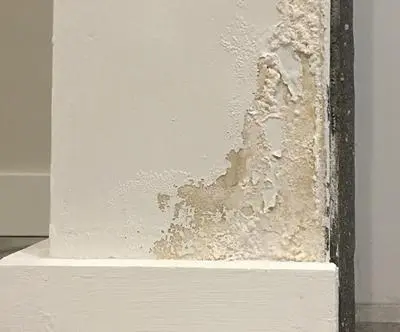
This doesn't look like mold growth. It appears to be deformation of the mud/plaster due to excess water. I recommend investigating further with a moisture meter. Your goal is to identify whether the water is 1.) Entering the wall from the backside (is there plumbing in this wall?) 2.) Occurring due to splashing water during shower usage, or 3.) Excessively wet mud/plaster was used during the install and is deteriorating as it dries out.
If it's the latter option, the moisture meter should show lower moisture content levels with each passing day.
Question:
Hi we having been smelling a moldy mildew smell for about5 months when we looking at the crawl space the entire bottom dirt was covered in mold white tat is what should we do the smell comes in the the heater vents really bad.
Mold growth on exposed soil in the crawl space is common. This is why it's critical to completely cover the soil with 6mil poly sheeting. This will prevent any mold spores (and odors) from entering the home. I also recommend air sealing any penetrations in the crawl space/subfloor. This will greatly reduce the amount of air flowing up from the crawl space into the home. By most estimates, 35% of the air in the main portion of your home comes directly from the crawl space.
Question:
I'm building a new home and we haven't even moved in yet and we noticed this this week.
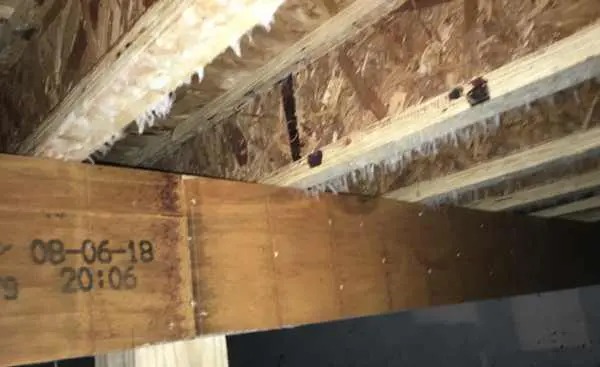
Unfortunately, this is fairly common in new construction. There are a couple of possible causes. The subfloor and joists often become saturated by rain before the roof is installed. Over the subsequent weeks, mold growth forms before the building materials can dry out. Another common cause is exposed soil in the crawl space. Most builders wait until the very end to install the vapor barrier. If the soil beneath the home is damp, this can create high humidity conditions in the crawl space. Over time this will cause mold growth on the joists.
Question:
Discovered this in crawl space. Wondering if you know what kind? We used fog machine with mold control and it came back.
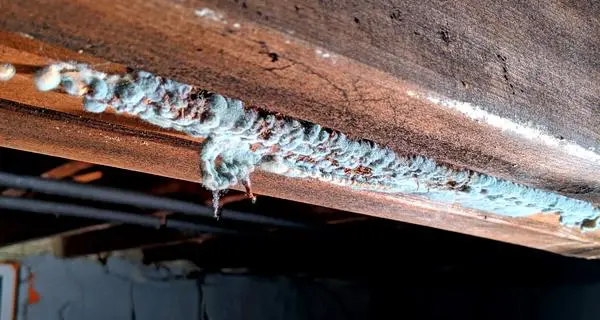
Interesting growth profile. It appears the mold is only growing on a specific substance adjacent to the joist. I can't tell what it is from the photo.
Any mildicide (such as a quanterary ammomium compound or Benefect) will kill the mold. In order to prevent regrowth, you'll need to eliminate the moisture source. Something is causing excess moisture in this specific area.
It also appears you have black mold growing on the bottom and side of the floor joist. If this is systemic throughout the crawl space, it likely indicates excess humidity/poor ventilation.
Question:
Hi there. I've recently noticed this on one of my walls I'm not sure what it is and my landlord is doing nothing about it. Can you hazard a guess at what I'm dealing with? I have a 4yr old and I'm worried about her health.
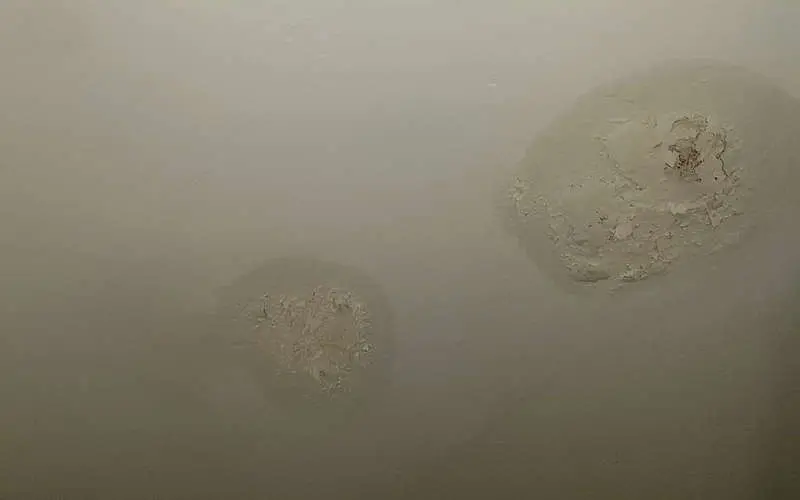
This looks like moisture from a water leak (as opposed to a humidity based issue). I would insist your landlord hire an inspector to investigate the issue. A moisture meter will determine conclusively if it's from a leak. The amount of mold growth at this time looks minimal, but it will likely worsen with time. Note – the mold growth will be worse on the backside of the sheet rock.
Question:
Hi! I recently just moved into a home and am beginning to move in furniture from my parents house. The piece that I am most concerned about is a wood and particle board king size bed that has a lot of drawers, nooks and crannies, etc. It was stored in a garage and I would say about 60% of it has been affected by white mold. I have sprayed it down with vinegar and wiped it down. But I am very skeptical about whether or not I can even successfully kill the mold that is on it. I am just wondering if I should call it a total loss or if it is actually possible to kill the mold. Also, how do I know if I have successfully killed it? Is there a period of time I should wait to see if it grows back??
Yes, it is possible to eliminate the mold growth. As you pointed out, the difficulty is in reaching the crevices. There are two primary cleaning techniques you can employ – HEPA vacuuming and damp wiping. The vacuuming is good for removing 3-dimensional growth from rough surfaces. Damp wiping with a mildicide is best done with a mildicide such as Benefect.
Thankfully, because you're dealing with a solid surface, you can readily judge the success of your cleaning. If you've thoroughly wiped the area and you don't see any surface growth, you're done. This is more difficult to determine with fully porous surfaces such as upholstered furniture or carpeting. With wood, it's straightforward.
Regarding worries about future growth, the mold won't return unless the wood encounters excess moisture again.
Question:
What are the causes of this mould in a wardrobe on an external wall.
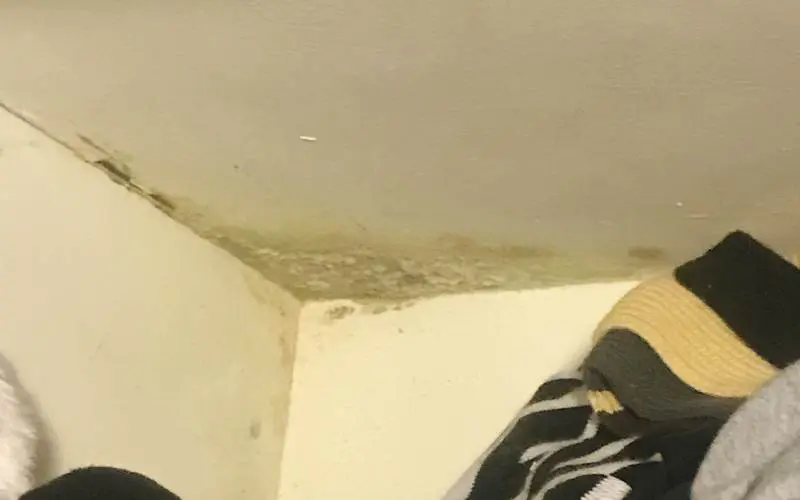
This is likely due to poor ventilation and inadequate insulation. This leads to a cold spot in the corner of the wardrobe which causes condensation. Over time this creates an environment conducive to mold growth. If possible, improve the insulation in this area. If not, create better air flow by removing contents and keeping a 3-4″ air gap between your items and the exterior wall. Improve your general ventilation in the home can help quite a bit (such as replacing your bathroom exhaust fan with a constant flow unit).
Question:
I have had my all items in an indoor climate controlled storage unit for 11 months while I save for a home. I had not been by for a few months and found these white dots where dust would be. It was present higher in the unit and on wood and leather. It does not smell musty. I have since cleaned it twice in the last 2 days with alcohol. I am wondering if my belongings are safe there for the next year and what I can do to prevent it. Thank you.
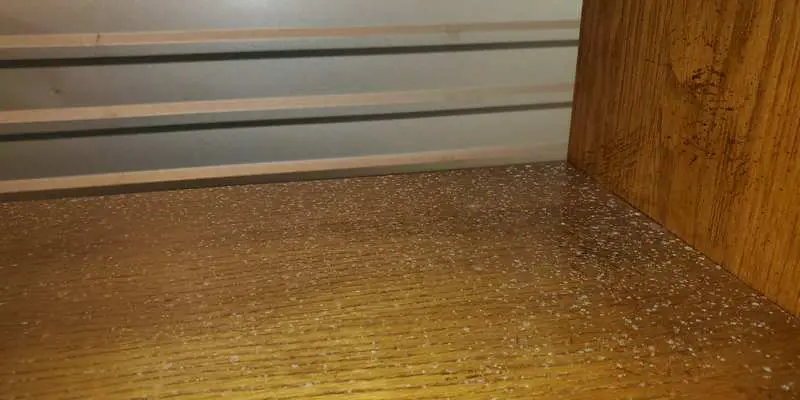
This is a tricky one. It looks somewhat like mold growth, but the pattern is unusual. I would collect a tape lift sample of the white substance and drop it off at a local lab. Also, purchase a relative humidity gauge to check the RH in the storage unit. It should stay below 55%.
Question:
Long story short I think I have both efflorescence and white mold. A while ago I noticed mold all over my shoes belts bags and other items in my CEDAR LINED CLOSETS in the garage and later some bubbling under the paint as well as crystalline areas growing in the basement so I went nuts and attacked with mold/mildew killer, bleach, ammonia, vinegar, lemon, tea tree oil, baking soda (and likely many other things) and I put moth balls, the hanging moth insert things, all of the diff products offered by damp-rid, and even a rechargeable thing w beads that lets you know when it's "wet" and time to "recharge and dry it out" all over the house both upstairs and down even though I'd never experienced any issues upstairs and it was quite dry upstairs in fact but I was taking all precautions. Recently I noticed a pair of expensive shoes I had only worn maybe three times that were hanging on a well-ventilated rack behind my bedroom door had white mold on it. I was horrified. I have since noticed that other shoes some I have never even worn and that have had no contact with the other shoes have also been infested. I'm devastated and hoping you are able to give me hope that I can get a handle on this and prevent the spread/return. It's quite expensive and the shoes range from latex to reg leather to suede to the insoles to some which are even nylon. would I be able to use the same product on all or likely not. I've sent just a pic of suede and latex shoes as I can only fit one pic.
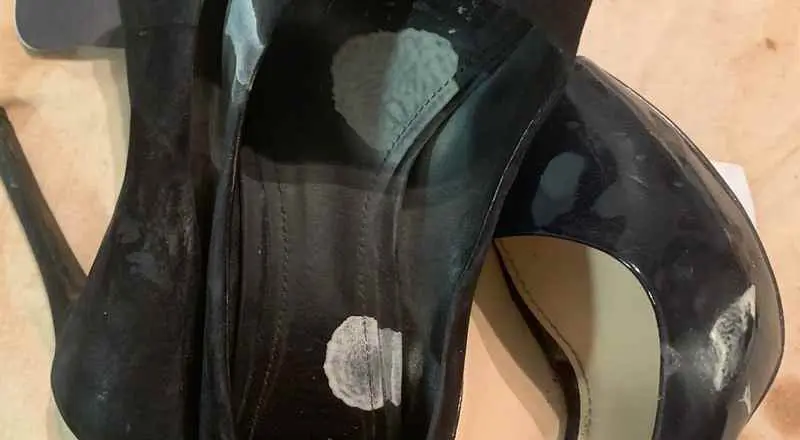
In the vast majority of cases, this type of mold growth is due to excess humidity. While the cedar will help prevent mold growth on the walls, it won't do anything to prevent growth on your clothes, shoes, etc. The Damp Rid style packets can help, but you'll likely need to take more extensive measures. First, you'll need to monitor the humidity. Purchase an inexpensive relative humidity monitor and place it in the closet. Your goal is to keep it below 55%. You might need a dehumidifier to keep it under this number.
Once this is achieved, cleaning chemicals will not be necessary. If you need to clean up past mold, using something like Benefect.
You'll also want to verify whether you have vapor emissions or other water intrusion issues. Contact a basement drainage / waterproofing contractor and have them inspect the area.
Question:
Thank you so much for this article! After reading this and looking at the pictures of others commenting I'm 100% sure that the back of my bedroom wall has white Mold. We have tried to get rid of it previously using bleach wipes and a Mold and mildew spray but it keeps coming back. We use dehumidifiers and try to keep the window open but the back wall where all the Mold is keeps getting really wet. To the point the double socket in the wall keeps short circuiting the house. Is there any suggestions on how to permimantly get rid of the Mold and prevent it from coming back?
This level of mold growth is likely due to a water intrusion (as opposed to humidity). The best way to definitively verify a leak is with a moisture meter. Wait until you experience a significant rain event to ensure you identify any leaks. Scan the area with a pinless moisture meter. These can often be obtained from a local contractor rental business.
If all else fails, cut a small hole in the sheet rock. If there's mold on the backside of the sheet rock, you have a liquid water intrusion. If it's only the room side of the wall, it's a condensation issue. This will also give you the opportunity to evaluate the insulation level within the wall.
Question:
I keep finding white mold on dark colored clothing in various closets in the past year. We have lived in the house 23 years and never had this problem. . We keep the house at 76F in summer and 68F in winter. We live in the South where humidity is high in summer, but this happens even in winter. We've looked for roof leaks, and found none. The closets are over a finished and unfinished basement. Any suggestions on finding the source / cause of the mild?
This sounds like it's a humidity based issue. I recommend purchasing a relative humidity gauge and mounting it in the closet. If it's consistently above 70%, this is likely the cause of the mold.
Closets often suffer from poor air movement, which leads to elevated humidity. Keep the closet doors open a bit to allow airflow. If this isn't possible, considering replacing the doors with a louvered model. Also, make sure there is sufficient space between the contents to allow for air circulation.
Your winter heat level is sufficient (68F). Increase your ventilation to the home whenever the outside air is cooler than 68F. The easiest way to do this is by running your bathroom exhaust fan continuously or on a programmable timer (i.e. the AirCycler SmartExhaust).
During the summer the only way to reduce the humidity is through your air conditioner/dehumidification. If you're continuing to see mold problems in the summer, despite opening the closet doors, I recommend hiring an HVAC company to evaluate or replace your air conditioner.
Question:
Hi I'd just like to start by saying thank you for your page it's really informative. I moved in to a private rented property about 18 months ago. There was quite a bit of black mould. Around windows, on walls on the fridge and the freezer (integrated). I've recently I've never been able to fully get rid of the black mould even though I clean regularly with bleach and use dehumidifiers. I've just recently noticed white mould growing on the bottom of my wooden furniture and black mould on the dogs bed all located in my front room. Could the mould actually be growing in my carpet? None of my furniture is touching any walls?
Based on your description, this is very likely a humidity problem. Whenever you see mold growth in multiple places (i.e windows, bedding, furniture) it's almost assuredly a humidity issue. I recommend buying a relative humidity gauge. See the guidance in the previous entry above.
The mold growth on the carpet requires a bit more investigation. Is the carpet on a concrete slab? Is so, you need to verify if you're dealing with vapor emissions through the concrete. This is very common. There is some good info on our basement mold page that should point you in the right direction.
It's possible the mold growth on the carpet is from the humidity. This typically only occurs in homes with very high humidity.
Regarding the cleaning, it is certainly worthwhile, but it will only postpone the issue. The only way to fully stop the mold growth is to solve the moisture problem
Question:
First of all, thanks for this great site! I'd be calling you to come to my house if we didn't live on the opposite coast! I am feeling like a real dummy now. I was very proud of myself for not running our air conditioning all summer. But now I am seeing mold on our furniture. I was cleaning the furniture with a vinegar solution, but I think from what I read here I need to use something stronger. My main question for you is whether I need to be concerned with the interior of the walls, carpeting, drapes, and so forth. In addition to cleaning the furniture, do I need to arrange for some kind of mold remediation in my house? I am sure this was just from humidity. There was no water intrusion that would have affected the furniture. Just open windows and a very humid summer.
I moved your question and answer over to the mold humidity page.
Question:
We moved into our house a year ago. It's only a 3 year old house. We just noticed what we think is white mold on many of our stored items throughout the basement. Is this mold? And should we call a professional or try to do it ourselves? I keep finding more and more items with this substance on them. We recently had the basement fogged for fleas as well if that makes a difference.
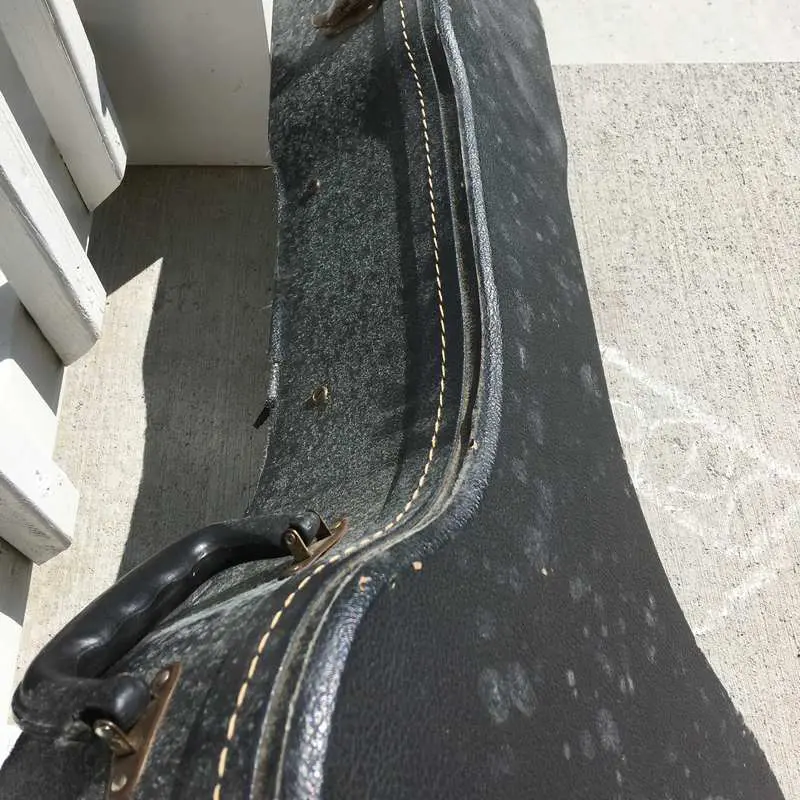
This is due to elevated humidity in the basement. Typically this occurs due to a lack of heat during the winter months. The lower temperature leads to increased humidity, which in turn causes the mold growth.
The easiest solution is to simply increase the temperature of the basement. Also, install a relative humidity gauge in a central location. Your goal is to keep the RH under 50% during the winter months.
In addition to increasing the temperature, you might need to actively ventilate the basement. Running an existing bathroom exhaust fan can achieve this. If no bathroom fan exists, you can install a wall mounted exhaust fan.
Question:
This is under my bed frame that made from wood. Any idea what is this? Thank you
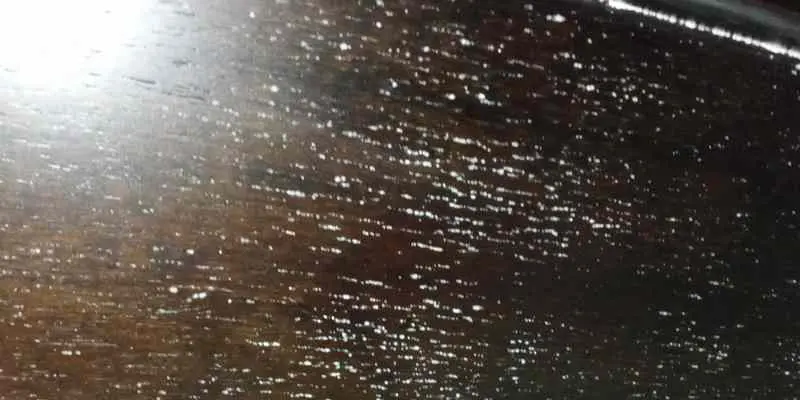
This looks like white mold growth. If the room is on a concrete slab, I recommend investigating the area for vapor emissions. If not, the problem is likely related to elevated humidity throughout the house. Depending on your climate, this can be dealt with either by increasing your ventilation or installing a dehumidifier. If the problem occurs during the winter months, increase ventilation. If it occurs in the summer, use a dehumidifier.
Question:
We have this weird white fuzzy/fluffy and kind of powdery stuff that seems to be growing on the bottom of the kitchen cabinets. It's only on upper cabinets on either side of our stove. When pressed between fingers it almost turns into a powder and disappears. When we touched it parts broke off and floated through the air like fake snow. What could this be?
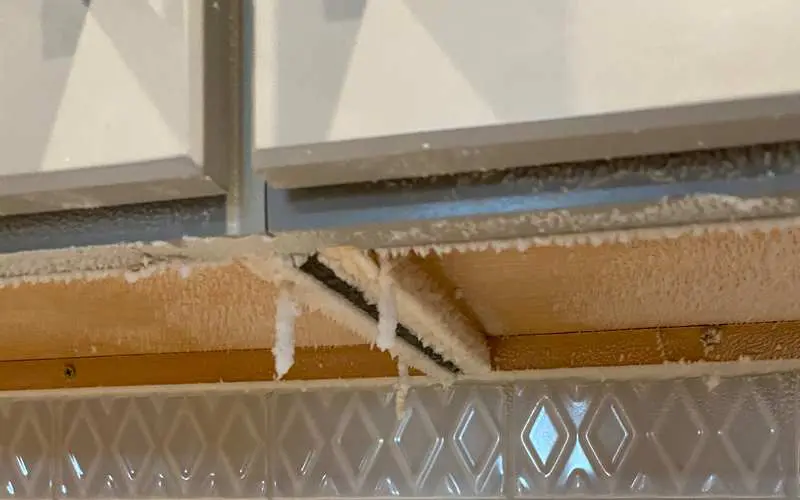
This is a weird one. The flaking off and floating in the air does not sound like mold growth. This is one of those very rare cases where I would recommend testing the substance. It's possible it is due to boiling large quantities of starchy foods such as potatoes, noodles, etc. Consider upgrading your range hood to a higher CFM model to ensure all vapors are exhausted during cooking/boiling.
Question:
Hello, I am converting my families VHS tapes to digital and a few have what appear to be white mold. Would you know the type that grows on tapes? This is a long process that will take a few weeks, how is it best to store the tapes and VCR? Is there anything I can place around the tapes to help reduce the spread to my place?
I wouldn't worry about identifying the specific type of mold growth. The remediation and prevention is the same, regardless of species. Your need to lower the humidity in the area these tapes are stored. Aim for a relative humidity of <50% with<60% as your maximum. If you live in a climate with cool winters, this can be achieved by increasing the ventilation to the storage area and increasing the heat/temperature. The higher the temp, the lower the RH. Purchase a relative humidity gauge to monitor your efforts. If you live in a very humid location such as Florida, you'll need active dehumidification.
Humidity problems are typically worse in closets or cabinets, due to the poor air flow. Try moving the tapes to an area that is more actively conditioned/heated.
Question:
I've had a reoccurring White mold issue in my clothes for years. It started with a dresser from a garage sale. Since then I have switched dressers, washed all my clothing several times with vinegar, borax, baking soda, detergent and bleach, but it always grows back. In the new dressers or boxes a dark stain that looks like clear oil will appear, and a white film with a musty smell is what always regrows on the clothes. It used to only grow on some clothing but sonce moving to an apartment with no air flow, it took over all of my clothes and now grows back within 1-4 days of washing. Maintenance installed a ceiling fan and told me to keep it on 24/7. I am planning to throw out everything affected by this mold, wash out my closets etc and buy new. Will that fix it? But more importantly what exactly should I use to wash the walls? No visible mold has ever appeared on walls or hard surfaces, just materials. Please help, I am low income and have to spend 50$ a month on laundry.
Mold growth on clothes and furniture is due to excessively high humidity. In a warm/humid climate such as the Southwest US, this occurs when the air conditioning is not adequately stripping the humidity from the air. In wet/cool climates such as the Pacific NW, this occurs in poorly heated rooms or closets with inadequate ventilation. The answer depends on your climate. If this is occurring during the winter months and you live in a cool climate, increase your heat and ventilation. The easiest way to improve ventilation is by simply running your closest bathroom exhaust fan 24×7.
If you live in a warm/humid climate, contact a HVAC company to investigate the issue.
In both scenarios, your goal is to keep the relative humidity (RH) below 60%, ideally below 55%. You can purchase an inexpensive RH gauge for ~$30 from a hardware store or online.
Question:
My house was remodeled before I bought it the previous owners (the renovators) did not replace the old drywall. I drilled into it and then my neighbor told me that there was mold. Got a test kit and sure enough mold. Is it recommended that I replace the drywall?
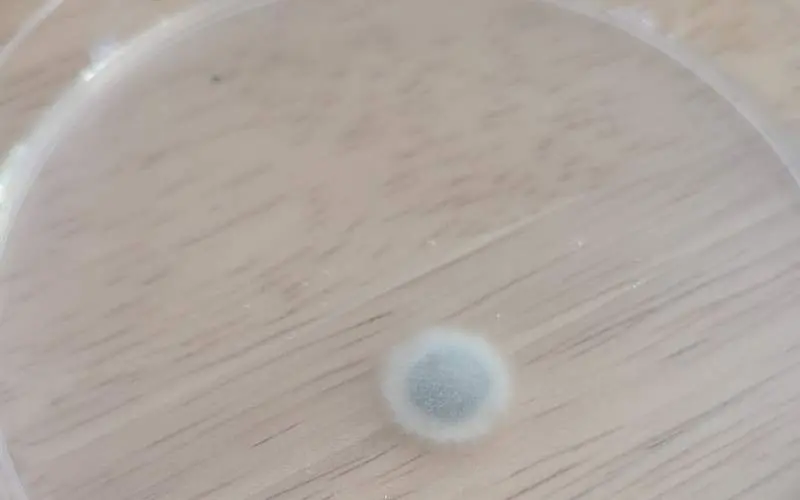
These types of test kits (petri style) are highly inaccurate. The substrate in the dish is designed as perfect food source for mold growth. Even the cleanest home will contain enough mold spores to cause growth on those kits.
I do not recommend replacing the drywall. The drywall acts as a containment barrier. If mold growth had occurred in the past, it is completely sealed and having no impact on the indoor air quality. Additionally, unless you're experiencing an ongoing water leak in the all, the mold growth is dead/dormant. It cannot grow without moisture.
Question:
My dad went to Heaven this past January and we are in the process of cleaning things out of his home. He had about 7 large cardboard boxes in his basement which contained Carole Town Christmas village pieces. Each of the pieces are packed in styrofoam in their original boxes. The outer cardboard boxes have mold growing on them, mostly on the outside, but some have it on the inside of the cardboard. It looks like white mold from the pictures I have seen on your website. Some of the boxes that the village pieces are packed in also have the white mold on them. If we remove the village pieces and just keep them in their styrofoam and pack them in new clean boxes, are we safe to transport them to our home and not spread the mold to our home? We would like to sell these pieces and were going to bring them home. Also I do not want to sell someone moldy pieces and spread mold to them!
Yes, I recommend remove the contents from the moldy boxes before moving anything to your home. I would perform the operation outside. Arrange a cleaning station to take the contents from the moldy boxes, wipe the items, then place them into clean boxes/bins.
If the contents are non-porous (i.e. ceramic, metal, etc.) they can be easily cleaned with a damp wipe. If the pieces are semi-porous, such as wood, they can be cleaned, but it may damaged the finish. Porous items are difficult to clean.
How To Get Rid Of White Mold
Source: https://www.environix.com/mold/learning/types-of-mold/white-mold/
Posted by: hurleydickclonsund1952.blogspot.com

0 Response to "How To Get Rid Of White Mold"
Post a Comment